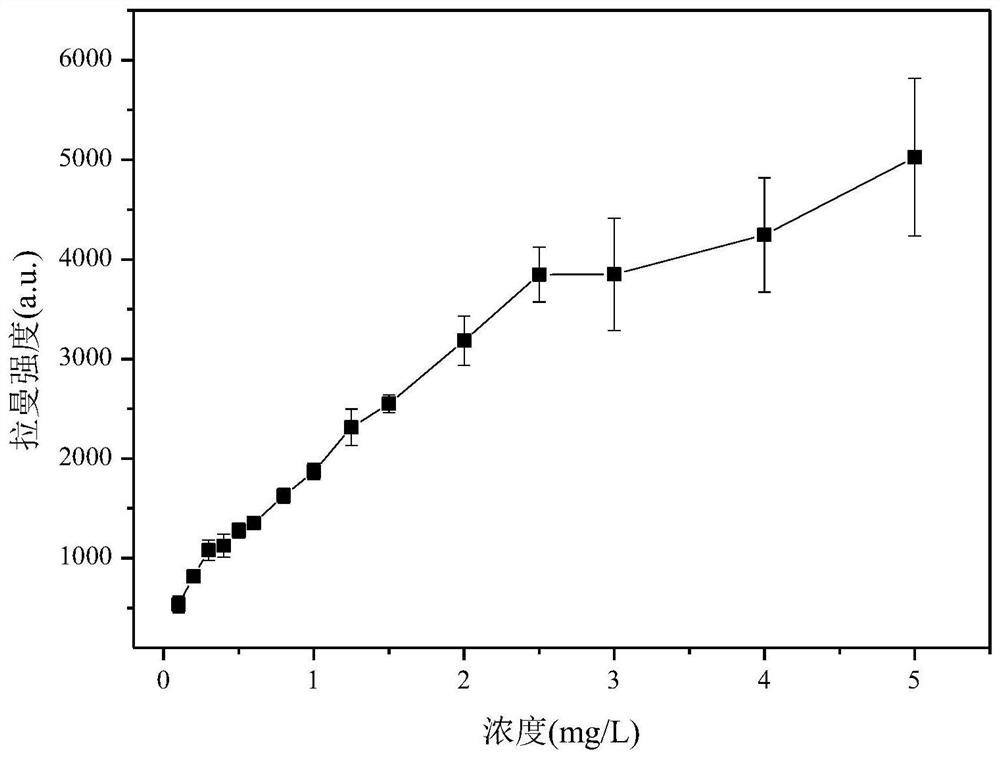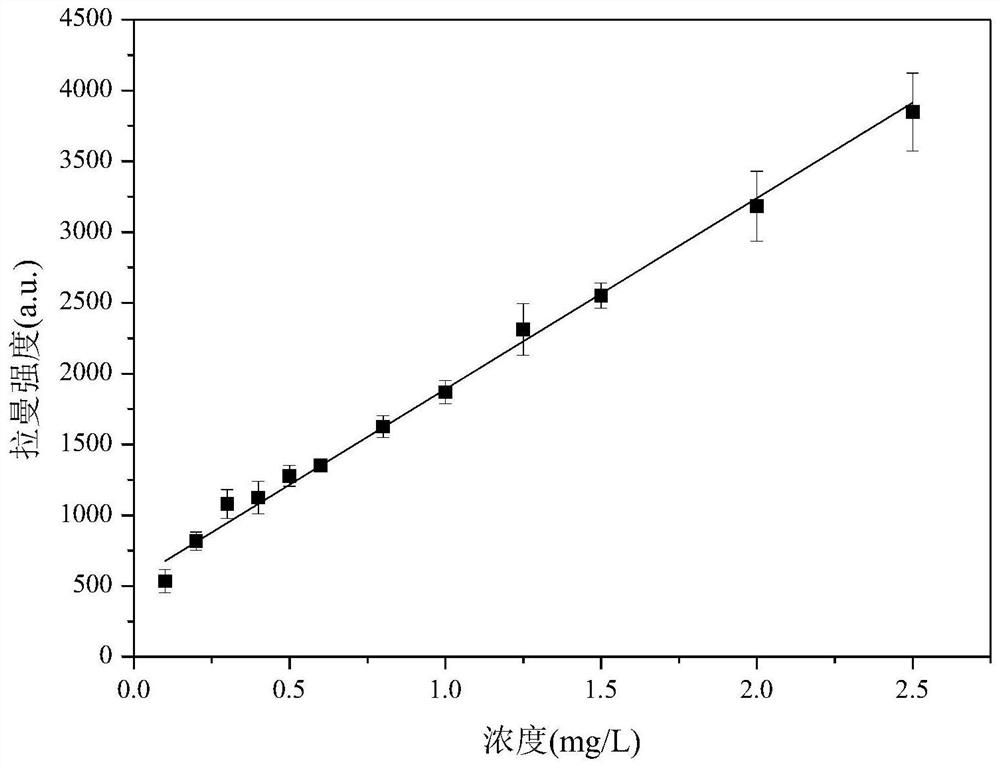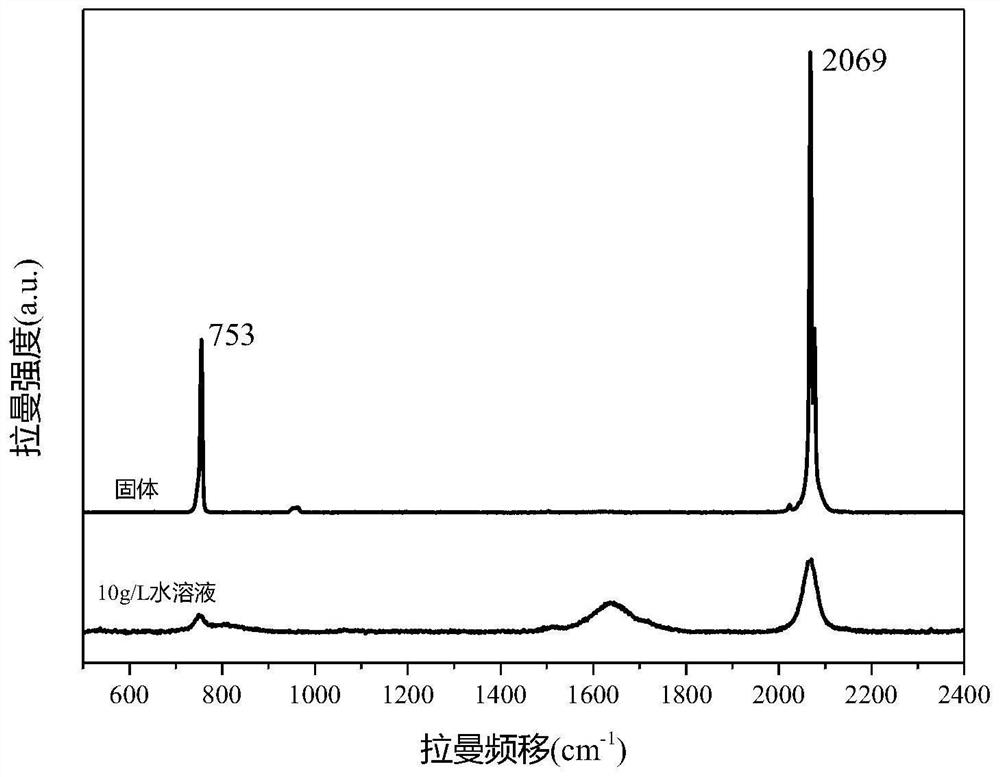Method for detecting sodium thiocyanate in milk based on mof sERS technology
A technology of sodium thiocyanate and technical detection, applied in the field of analysis and detection, to achieve the effects of simple pretreatment method and detection operation, improved capture ability, and improved surface plasmon resonance performance
- Summary
- Abstract
- Description
- Claims
- Application Information
AI Technical Summary
Problems solved by technology
Method used
Image
Examples
Embodiment 1
[0052] Preparation of Example 1 Substrate
[0053] The preparation method of nano-silver SERS substrate grown on the surface of MIL-101(Fe) material includes the following steps:
[0054] (1) Synthesis of MIL-101(Fe) material:
[0055] Weigh 0.675g of ferric chloride hexahydrate and 0.206g of terephthalic acid, add in 15mL of dimethylformamide, stir and dissolve to obtain a mixed solution; then transfer the mixed solution to a tetrafluoroethylene-lined heating kettle, It was placed in a muffle furnace, heated and reacted at 150°C for 6 hours, and cooled to room temperature to obtain an orange-yellow product; the product was centrifuged at 10,000 rpm for 10 minutes to collect the precipitate, and the obtained orange-yellow solid precipitate was treated with dimethylformamide and Wash three times each with absolute ethanol, and dry at 70°C for 3 hours to obtain an orange solid powder, namely MIL-101(Fe) material powder;
[0056] (2) preparation concentration is the silver nitr...
Embodiment 2
[0060] Construction of Example 2 Model
[0061] The construction method of the linear model of the characteristic peak intensity of sodium thiocyanate and the concentration of sodium thiocyanate includes the following steps:
[0062] (1) Prepare the mother liquor of sodium thiocyanate with a concentration of 1g / L, then take the mother liquor and dilute to 1, 2, 3, 4, 5, 6, 8, 10, 12.5, 15, 20, 25, 30, 40, 50mg respectively. / L standard solution of sodium thiocyanate;
[0063] (2) The standard solutions of sodium thiocyanate of different concentrations and milk are mixed uniformly according to the volume ratio of 1:9 to form milk sample solutions of different concentrations of sodium thiocyanate;
[0064] (3) according to the milk sample liquid and ethanol according to the volume ratio of 1:1 mix evenly, centrifuge to obtain the supernatant of different sodium thiocyanate concentration;
[0065] (4) The supernatant and the nano-silver SERS substrate grown on the surface of th...
Embodiment 3
[0070] A method for detecting sodium thiocyanate in milk based on surface-enhanced Raman technology (such as Figure 4 ), including the following steps:
[0071] (1) the milk with the sodium thiocyanate concentration of 0.5, 1, and 1.5 mg / L is mixed with absolute ethanol according to the volume ratio of 1:1, and centrifuged to obtain a supernatant;
[0072] (2) The supernatant and the nano-silver SERS substrate grown on the surface of the MIL-101(Fe) material prepared in Example 1 were uniformly mixed according to a volume ratio of 1:1, and allowed to stand for 4 minutes to conduct Raman detection to obtain the Raman spectrum (eg Figure 5 );
[0073] (3) Set the Raman spectrum obtained in step (2) at 2110 cm -1 ±5cm -1 The intensity of the characteristic peak of sodium thiocyanate is substituted into the linear model of the intensity of characteristic peak of sodium thiocyanate and the concentration of sodium thiocyanate in Example 2 to obtain the concentration of sodium ...
PUM
| Property | Measurement | Unit |
|---|---|---|
| strength | aaaaa | aaaaa |
Abstract
Description
Claims
Application Information
 Login to View More
Login to View More - R&D
- Intellectual Property
- Life Sciences
- Materials
- Tech Scout
- Unparalleled Data Quality
- Higher Quality Content
- 60% Fewer Hallucinations
Browse by: Latest US Patents, China's latest patents, Technical Efficacy Thesaurus, Application Domain, Technology Topic, Popular Technical Reports.
© 2025 PatSnap. All rights reserved.Legal|Privacy policy|Modern Slavery Act Transparency Statement|Sitemap|About US| Contact US: help@patsnap.com



